Melaka to Penang
Tuesday 5 October 1999 – Monday 11 October
1999
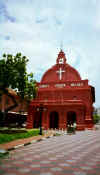 It
took us only a few hours in a bus to get from Singapore to Melaka on the west
coast of peninsular Malaysia. In
the 15th century Melaka was the greatest trading port in Southeast Asia,
and although its importance has long since declined, it retains distinct
reminders of its rich history and a fascinating mix of Chinese and European
culture. It was colonized by no less than three of the major
European powers of the time, starting with the Portuguese in 1509, followed
by the Dutch and finally by the British to whom it was permanently ceded in
1824.
It
took us only a few hours in a bus to get from Singapore to Melaka on the west
coast of peninsular Malaysia. In
the 15th century Melaka was the greatest trading port in Southeast Asia,
and although its importance has long since declined, it retains distinct
reminders of its rich history and a fascinating mix of Chinese and European
culture. It was colonized by no less than three of the major
European powers of the time, starting with the Portuguese in 1509, followed
by the Dutch and finally by the British to whom it was permanently ceded in
1824.
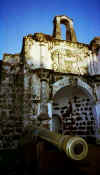 Among
some of the most fascinating relics are the ruins of St Paul’s Church built by
the Portuguese in 1521 on a small hill overlooking the harbour.
By the time the British arrived, it had fallen into disuse and was used
as a gunpowder store but is nonetheless a beautiful setting and many of the
walls are still as imposing as they were originally, with several old Dutch
tombstones lining the interior.
Among
some of the most fascinating relics are the ruins of St Paul’s Church built by
the Portuguese in 1521 on a small hill overlooking the harbour.
By the time the British arrived, it had fallen into disuse and was used
as a gunpowder store but is nonetheless a beautiful setting and many of the
walls are still as imposing as they were originally, with several old Dutch
tombstones lining the interior. 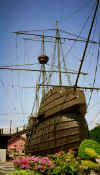 Down the hill, the Porta de Santiago, once
the main gate, is all that remains of the Portuguese fortress A’Famosa
constructed in 1512. Next to it is
a wooden replica of the Melaka sultan’s palace which today houses the cultural
museum.
Down the hill, the Porta de Santiago, once
the main gate, is all that remains of the Portuguese fortress A’Famosa
constructed in 1512. Next to it is
a wooden replica of the Melaka sultan’s palace which today houses the cultural
museum.
Although
Melaka has long lost its importance as a port, ancient-looking Sumatran
schooners still sail up the river and moor at the banks.
Today their cargo is generally lumber from Indonesia rather than varied
treasures of the east. To
round off our sightseeing, we snuck in few of the old Chinese temples, one of
which is said to be the oldest in Malaysia.
All the materials used in building the original temple were imported from
China, as were the artisans who designed and built it.
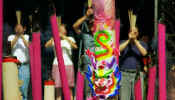
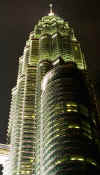 Our
next stop was Kuala Lumpur, a four hour bus ride from Melaka.
With only an afternoon to fit in the key sights, we actually found we had
plenty of time to navigate our way around.
There was plenty of inventive colonial architecture, but the most impressive
sight was the recently completed Petronas Towers. Some 450 metres (about
1500 feet) high with no less than 88 stories, these towers are arguably the
tallest buildings in the world (yes, people do argue about these things). Their
floor plan is based on an eight-sided star pattern, which echoes the
Our
next stop was Kuala Lumpur, a four hour bus ride from Melaka.
With only an afternoon to fit in the key sights, we actually found we had
plenty of time to navigate our way around.
There was plenty of inventive colonial architecture, but the most impressive
sight was the recently completed Petronas Towers. Some 450 metres (about
1500 feet) high with no less than 88 stories, these towers are arguably the
tallest buildings in the world (yes, people do argue about these things). Their
floor plan is based on an eight-sided star pattern, which echoes the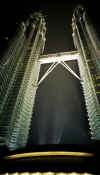 arabesque patterns of Islamic art, and even the masts reflect architectural
traits from both the minarets of a mosque and the star of Islam.
When seen at night, the distinctive silver towers are spectacular.
arabesque patterns of Islamic art, and even the masts reflect architectural
traits from both the minarets of a mosque and the star of Islam.
When seen at night, the distinctive silver towers are spectacular.
The next morning, we were back
at the bus station, this time in search of a public bus to take us to Fraser’s
Hill, one of Malaysia’s hill
stations that supposedly retains a great deal of colonial charm. Being British, Pippa had an uncontrollable desire to visit
those towns inhabited by her forefathers, and hill stations held a particular
appeal for her. Armed with her
sightseeing bible, The Great Hill Stations of Asia, she was determined we would visit at
least one British hill station in every country we visited and Fraser's Hill was
to be our first. This was unfortunate for Eric, as it turned out they were
all quite tacky and depressing places. He even refused to take
pictures.
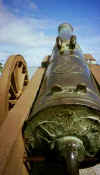 Hill stations, for some reason,
are still popular retreats with the more affluent members of today’s society
but luckily we were out of season and found we had the place pretty much to
ourselves, other than some surly hotel staff and the odd bird spotter or two.
We were to soon learn that this is one of the great bird-watching meccas of Asia
– over 265 species sighted to date, 100 of which are resident.
Not that we could tell a flycatcher from a bee-eater, but Fraser’s Hill
is made for walking and we certainly saw a multitude of two-winged denizens.
After two days of rain, we descended once again to the heat of the lowlands and
made our way north, once again by bus, to the island of Penang.
Hill stations, for some reason,
are still popular retreats with the more affluent members of today’s society
but luckily we were out of season and found we had the place pretty much to
ourselves, other than some surly hotel staff and the odd bird spotter or two.
We were to soon learn that this is one of the great bird-watching meccas of Asia
– over 265 species sighted to date, 100 of which are resident.
Not that we could tell a flycatcher from a bee-eater, but Fraser’s Hill
is made for walking and we certainly saw a multitude of two-winged denizens.
After two days of rain, we descended once again to the heat of the lowlands and
made our way north, once again by bus, to the island of Penang.
Penang is the oldest British
settlement on the Malay peninsula, predating both Melaka and Singapore, and is
today one of Malaysia’s major tourist attractions.
We had not come to check out the beaches, however, and in the 24 hours we
had, we really only got to see what the main city Georgetown itself had to offer.
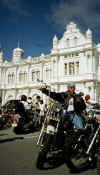
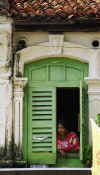 Perhaps not surprisingly, many of the grand colonial
buildings are still in place including the old Fort Cornwallis.
There is even a Victoria Memorial Clock Tower, donated by a local Chinese
millionaire to honour Queen Victoria’s Diamond Jubilee in 1897.
It stands 60 feet tall – one foot for each year of her reign. Away
from the colonial district, there is also the ubiquitous Chinatown, although
pockets of Malay and Indian areas remain around it.
It’s a beautiful area to walk around and take in the old Chinese shop
houses and the early morning or late night markets.
There seemed to be a surprise around every corner, including a big
motorcycle rally and a parade.
Perhaps not surprisingly, many of the grand colonial
buildings are still in place including the old Fort Cornwallis.
There is even a Victoria Memorial Clock Tower, donated by a local Chinese
millionaire to honour Queen Victoria’s Diamond Jubilee in 1897.
It stands 60 feet tall – one foot for each year of her reign. Away
from the colonial district, there is also the ubiquitous Chinatown, although
pockets of Malay and Indian areas remain around it.
It’s a beautiful area to walk around and take in the old Chinese shop
houses and the early morning or late night markets.
There seemed to be a surprise around every corner, including a big
motorcycle rally and a parade.
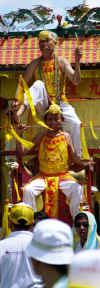
Pippa thought there was much more to see on the island,
but Eric had endured quite enough British colonial nonsense and the next
afternoon, we were heading for the central train station back over on the
mainland for an overnight train to Bangkok, and thence by air to Laos.